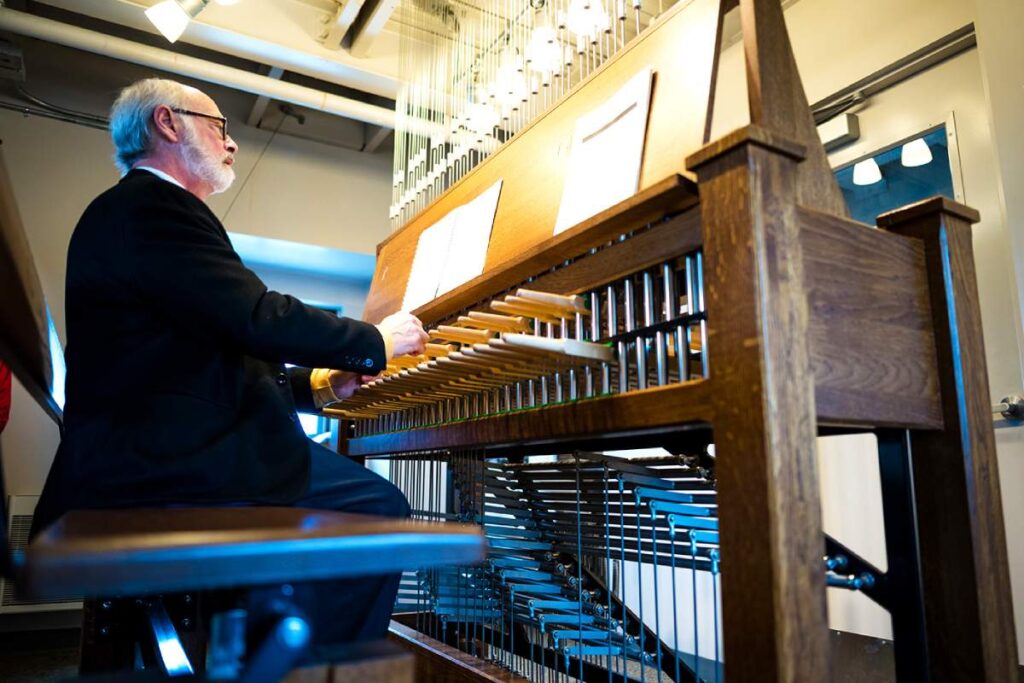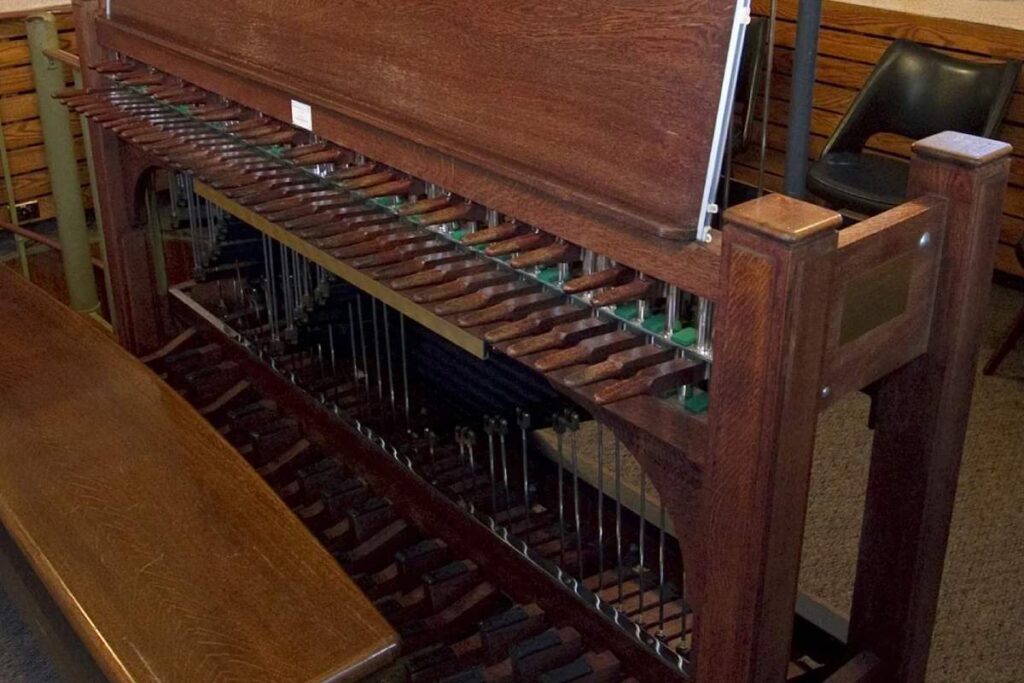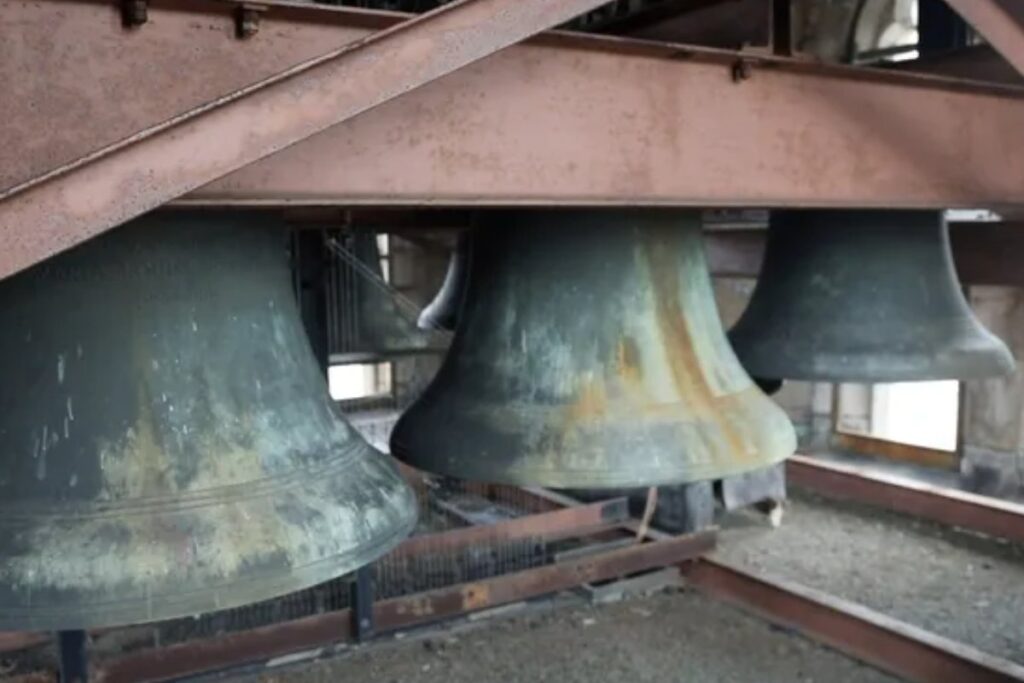Discovering the Carillon Instrument and Its Legacy

Carillon Instrument
The carillon is not just a regular instrument but a gateway to a world of enchanting melodies and timeless stories.
A carillon is a musical instrument, but it’s not like a guitar or a piano.
It doesn’t have strings or keys. Instead, it has a set of large bells, each carefully tuned to produce a specific musical note, at its heart.
The way a carillon looks depends on how many bells it has and how heavy they are.
These bells can be in towers that stand all by themselves or connected to a building.
Sometimes, you can see the bells, and other times they are hidden inside the tower.
In this article, we will take a delightful journey through the world of carillons.
We will explore their history, how they work, the magic they create, and the places where you can experience their captivating tunes.
What is a Carillon Instrument?

A carillon is a huge musical instrument that belongs to the percussion family and is made up of a set of tuned bells.
To create a proper carillon, you need a substantial number of bells, typically at least 23 sets. This specific number is necessary for an instrument to be classified as a carillon; otherwise, it is referred to as a chime.
These bells are usually made from bronze and can come in various sizes. They range from small ones that can fit in your hand to massive ones that weigh several tons.
Furthermore, they are stationary, suspended in a purpose-built bell tower known as a belfry.
Carillons come in all sorts of shapes, sizes, and sounds. They’re actually some of the heaviest musical instruments out there!
The heaviest carillon ever weighs more than 91 metric tons (which is like 100 short tons). Most carillons weigh between 4.5 and 15 metric tons (around 5.0 to 16.5 short tons).
Typically, a regular-sized carillon has about 50 bells, but the biggest ones can even have up to 77 bells!
These bells are unique because they are carefully tuned and arranged in a specific order, known as chromatic order.
The arrangement enables the instruments to produce harmonious sounds and beautiful music when played together.
To play the carillon, carillonneurs use a keyboard, similar to an organ or piano’s keyboard. However, instead of a regular keyboard, the carillon uses wooden sticks for the hands and pedals for the feet.
As mentioned earlier, you can find carillons in tall bell towers, often associated with churches, universities, or even some cities.
They serve not only as musical instruments but also as timekeepers, playing simple songs throughout the day.
So, when you hear those lovely bell sounds, you’re actually listening to a large musical instrument in action!
Etymology of the Carillon
The word “carillon” has an interesting history, dating back to late 18th-century France.
It comes from the Old French word “carignon,” which was originally “quarregon,” meaning “a set of four bells.”
“Quarregon” itself has its roots in the Latin word “quaternionem,” which means “set of four,” derived from “quater,” which means “four times.”
Some suggest that “carillon” might have initially referred to a group of four forestrike bells that played melodies to announce the time signal of public hour bells. However, this idea isn’t confirmed by historical records.
However, there’s strong evidence indicating that “carillon” originally referred to a medieval practice where church bells were chimed in sets of four by pulling their clappers using ropes.
In German, besides using the French term, a carillon is sometimes called a “Glockenspiel,” which literally means ‘bells set.’
However, it’s important not to confuse it with the similarly named “glockenspiel.”
Dutch speakers use the word “beiaard,” which has an uncertain origin.
What Is a Carillon Player Called?

A musician who plays the carillon is often called a carillonneur. This skilled individual uses the carillon instrument to perform various types of music, including original compositions and arrangements of classical and popular pieces.
The term “carillonneur” is borrowed from French. It was introduced to English speakers after the carillon instrument was brought to British troops following the War of the Spanish Succession in the 18th century.
Interestingly, while “carillonneur” technically refers to male carillon players, the corresponding French term “carillonneuse” for women isn’t commonly used in English.
Another term that’s often used is “carillonist,” which some carillon players prefer because it’s gender-neutral, easy to spell, and has clear pronunciation.
In 2018, the World Carillon Federation decided to use “carillonist” as its preferred term in communications.
A carillonneur operates the carillon’s mechanism, somewhat similar to an organ. This mechanism activates a complex system of internal clappers or external hammers to make the bells ring.

Like a pianist, a carillonneur can create chords, harmonies, and melodies on their instrument, sending beautiful tunes drifting over rooftops.
The more bells a carillon has and the more skilled the carillonneur, the wider the range of music they can produce.
Some carillons are even equipped with mechanisms that allow them to play automatically without a carillonneur present.
While carillonneurs often perform as solo artists, they have formed professional associations to promote carillon culture. Carillonneurs from around the world make up an international community of musicians who collaborate on arranging, composing, and playing music together.
History of the Carillon Instrument

The carillon is an incredible musical instrument with a history that’s both rich and long. For over five centuries, it has served as a means to express the hopes, dreams, and joys of people.
The practice of playing melodies on a set of small bells, arranged in a graduated order and struck by hand, is believed to have ancient origins. This belief is supported by occasional depictions of such systems in medieval manuscripts.
The carillon, with its intriguing history, traces its roots deep into the annals of the Middle Ages. It all commenced with the utilization of bells for two primary purposes: conveying messages and marking the passage of time.
In those medieval times, individuals known as bell ringers would affix ropes to the clappers of stationary bells.
Instead of allowing the bells to sway freely, they skillfully struck them while the bells remained in place.
This method, known as chiming, afforded them greater control over the bells.
Chiming served as an effective means of communication, enabling the transmission of vital information such as warnings of fires or impending attacks.
During joyous occasions, like festive celebrations, these adept bellringers would congregate and collectively manipulate the ropes to produce melodious tunes from the bells.
Remarkably, as early as the 15th century, this technique was being employed to create music through the medium of bells.
A historical account dating back to 1478 tells of a man in Dunkirk who demonstrated a remarkable ability to play intricate melodies on bells.
Furthermore, a tale from 1482 recounts the exploits of a jester in Aalst, who, in Antwerp, ingeniously employed ropes and batons to elicit harmonious sounds from the bells.
This hints at the existence of a keyboard-like mechanism for these musical instruments during that era.
ALSO READ: History of the Carillon
Origin of the Carillon Instrument
During the 14th century, a new technology called escapement found its way into European clock towers, gradually replacing the water clocks of that era.
In those early days of timekeeping, clocks didn’t have faces like the ones we see today. Instead, they told the time by striking a bell a specific number of times to indicate the current hour.
As time passed, these striking clocks underwent improvements. They began incorporating a warning signal that sounded just before striking the hour to get people’s attention.
This warning signal was known as the forestrike (referred to as voorslag in Dutch).
Initially, the forestrike was quite simple, typically involving just one or two bells. However, as time progressed, it became more sophisticated.
By the middle of the 15th century, forestrikes with three to seven bells could even play basic melodies.
Interestingly, as late as 1510, an individual at Oudenaarde Town Hall in the Low Countries, encompassing modern-day Belgium, the Netherlands, and the French Netherlands, combined these two functions. This resulted in the creation of an early version of the carillon.
They linked a set of nine bells to both a keyboard and the clock’s forestrike.
This region had a particular interest in using bells to produce music, and their expertise in bell-making surpassed that of other European regions.
Emergence of the Carillons
The carillon was a successor to the early medieval cymbala and first came into existence in the lowlands of Holland, Belgium, and northern France.
Specifically, it gained significant popularity in Holland during the 14th and 15th centuries.
In this era, impressive mechanical instruments, equipped with sets of tuned bells, found their home in the towers of churches and city halls, connected to the town’s clock.
In these bustling towns, they showcased their prosperity by installing impressive carillons in their church towers.
These carillons were equipped with automatic mechanisms that played tunes every quarter hour, sometimes even more frequently. A rotating cylinder with pins was used to release hammers that played melodies at specific times.
On special occasions, like market days and holidays, the town carillonneur would perform. In many towns across the Low Countries, the carillon served as a significant cultural symbol.
Its enchanting sound filled the air several times a day, delighting hundreds of listeners, and it often became an integral part of the town’s identity.
People believed that well-functioning bells and good schools were indicators of a well-administered city.
Development of Carillon
The 17th century was a big time for the carillon’s growth. In the Low Countries, where the carillon was really taking off, the bell makers got more money and better technology to make these musical instruments.
Because of this, carillons became a source of pride for cities. Consequently, they started competing to have the biggest and best ones.
Much like how Italian cities vied with each other in creating architectural wonders, the northern cities were driven by the ambition to possess exceptionally flawless carillons. They sought perfection in both technical precision and tonal quality.
They continuously expanded the number of bells, creating instruments with more than 50 bells and cylinders adorned with thousands of pins.
Sometimes, they even added mechanical figures to enhance the spectacle.
Families like the Waghevens and Vanden Gheyns were super successful in making carillons. They made over 50 of them during the 16th and early 17th centuries.
By 1600, the basic carillon had become a common and well-liked thing in the area.
Starting in the 16th century, carillons could be played not just mechanically but also through a keyboard.
As larger bells and hammers were developed towards the end of the Renaissance, a pedalboard was added to handle the deeper notes.
The carillon, comprising a collection of bells, reached its zenith in the 17th century. There was hardly any need for further technical enhancements after the Renaissance.
In its final form, the instrument became increasingly common in central and western Europe, including England.
However, in these regions, it never achieved the same level of popularity as in its true homeland of Belgium, Northern France, and Holland.
Decline of the Carillon Instrument
The French Revolution had a significant impact on the Low Countries and the popularity of carillons.
When the French took over in 1795, they wanted to use bell bronze for copper, so they tried to take apart local carillons.
Carillon owners resisted by asking the new governments to protect their instruments as “culturally significant” or by hiding the bells.
During that period, some of the carillon bells were disconnected and buried in secret.
At that time, there were about 110 carillons, but nearly 50 of them were destroyed due to war, fire, and dismantling.
They melted down most of them to forge cannons for the French Revolutionary Wars.
Revival of the Carillon Instrument

As the French Revolution swept through, the carillon lost some of its popularity.
Subsequently, numerous carillons were tuned using meantone temperament, making them unsuitable for the chromaticism of emerging musical styles.
As a result, new musical compositions for the instrument almost ceased, and there was a notable decline in the skill level of carillonneurs.
However, John William Taylor later collaborated with Simpson, and in 1904, they introduced the first tuned bells in more than a century. This rediscovery sparked a resurgence in carillon construction.
Jef Denyn also played a pivotal role in revitalizing the carillon as a musical instrument in Mechelen, Belgium.
As his carillon-playing skills improved and the carillon in the tower of St. Rumbold’s Cathedral was upgraded, Denyn’s performances started attracting large audiences.
On August 1, 1892, Denyn hosted the world’s first carillon concert. This marks a turning point where the instrument gained recognition as a concert instrument rather than merely a provider of background music.
Yet, in the 20th century, renewed interest in carillons emerged, driven by developments in Belgium, England, and the United States.
From 1922 to 1940, bellfounders placed 43 carillons in the United States and Canada.
This increase in carillons in North America can be attributed to Rice’s highly popular books.
One of these books, titled “Carillons of Belgium and Holland,” was the first in English to focus on carillons. It was first published in December 1914 and went on to be reprinted three times.
Additionally, Rice’s continuous efforts to educate people in the United States played a crucial role in this expansion.
How to Play a Carillon
Have you ever wondered how those massive bells can produce such beautiful sounds? Well, it’s all about precision and technique.
The carillon, a unique keyboard instrument, shares similarities with others like the organ or pedal piano. However, its playing console stands out.
Carillonists play this instrument using their hands on a special manual keyboard made of rounded wooden batons.
These keys resemble a piano’s, with short chromatic keys (the “black keys”) raised above the diatonic keys (the “white keys”).
They are spaced widely apart, with the chromatic keys standing about 10 centimeters (4 inches) above the rest. To play, you press these keys with a closed fist.
When you play the carillon, it’s not like striking the bells with a hammer, as you might imagine.
Instead, you use your fists or feet to push down on levers connected to the clappers inside the bells.
This action makes the bells swing, and as they swing, they produce their notes.
The lowest 1.5 to 2.5 octaves of the manual are linked to a pedal keyboard operated by the feet.
This connection is direct, so when you press a pedal, it pulls down its corresponding key on the manual.
Playing the carillon is a delicate art that demands skill and practice.
Carillon Performance
Playing the carillon involves two main types of performances: recitals and concerts.
Carillon recitals are the usual, regular performances scheduled throughout the week.
They’ve been a tradition since the instrument was first created and remain fundamental to carillon playing.
Concerts, on the other hand, are special performances where there’s a planned program and a designated area for the audience to sit and enjoy.
Some carillonneurs even livestream their performances, allowing the audience to watch them play.
The very first carillon concert happened on August 1, 1892, as part of Jef Denyn’s Monday evening concert series.
Because not everyone is consistently interested in traditional performances, carillonneurs have started to try out new and collaborative musical ventures, collectively known as “Carillon Plus”.
Some carillonneur duos are exploring the potential for playing duets and creating fresh music for this type of setup.
Others are looking into incorporating the carillon into orchestras, bands, and different kinds of musical groups.
While Carillon Plus performances aren’t entirely new, they’ve been studied more closely since the mid-20th century.
Carillon Instrument Repertoire
Today, carillonneurs have a wide and ever-expanding range of music at their fingertips.
In the past, before the twentieth century, their choices were mostly limited to improvisations and reworked versions of existing pieces.
While we know of about 15 sets of carillon music from the 17th and 18th centuries, early carillon performances were much like those of the pipe organ—mostly improvised.
However, nowadays, a significant part of the carillon’s repertoire is made up of brand-new compositions crafted especially for this instrument.
In contrast to the organ repertoire, which leans heavily on older pieces, the carillon’s collection of music focuses more on newer compositions.
Despite this wealth of original works, arrangements still hold an important place in the carillonneur’s repertoire.
In fact, carillon concerts and regular performances typically strike a balance between original compositions and arrangements.
Arrangements, in particular, play a crucial role in helping carillonneurs connect with the diverse communities that form their audience.
This makes the skill of arranging for the carillon both valuable and essential for any carillonneur!
Old Carillon Repertoire
During the late Renaissance and early Baroque periods, keyboard music wasn’t specifically written for one instrument; it could be played on any keyboard instrument.
This means that much of the early carillon repertoire was likely the same as that of the harpsichord, organ, and piano.
One example that has survived is the De Gruytters carillon book from 1746. The music was designed for performance on the carillon but could also be played on other keyboard instruments.
Baroque keyboard music, especially pieces by composers like Bach, Corelli, Couperin, Handel, Mozart, and Vivaldi, is particularly well-suited for carillon transcription.
20th Century Carillon Repertoire
The very earliest original compositions created specifically for the carillon, rather than for any keyboard instrument, are Matthias Vanden Gheyn’s 11 preludes.
The structure of his pieces suggests that he had been playing non-specific keyboard music on the carillon for many years before deciding to create music that truly suited the instrument.
Despite their technical difficulty, Vanden Gheyn’s preludes have become a standard part of every carillonneur’s repertoire since the early 1900s.
Additionally, Ronald Barnes played a significant role in shaping the North American style of carillon music in the 1950s and 1960s.
He encouraged his colleagues at the University of Kansas to compose specifically for the carillon. He also created many of his own compositions.
His efforts were most successful with Roy Hamlin Johnson, a piano professor who introduced a whole category of music exclusively tailored for the carillon, featuring a unique musical scale.
Many of Johnson’s works are considered masterpieces. Overall, Barnes created 56 original compositions and numerous arrangements to enrich the available repertoire.
Other notable contributors in the 20th century included Albert Gerken, Gary C. White, Johan Franco, John Pozdro, and Jean W. Miller.
At Phamox Music, we go all out for exactness and honesty. For this purpose, if by any means you found any possible glitch, be it factual, editorial, or something that we need to update, kindly contact us.
If you find the information provided in this post “Carillon Instrument” interesting and helpful, kindly share it with someone you know that might need it.







